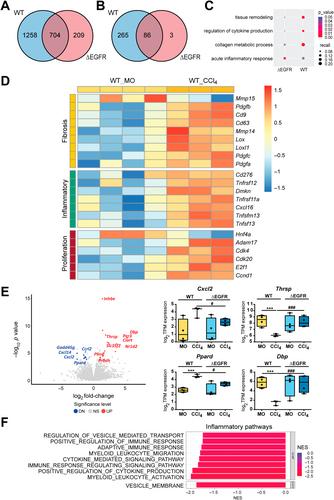Ester Gonzalez-Sanchez, Javier Vaquero, Daniel Caballero-Diaz, Jan Grzelak, Noel P Fusté, Esther Bertran, Josep Amengual, Juan Garcia-Saez, Beatriz Martín-Mur, Marta Gut, Anna Esteve-Codina, Ania Alay, Cedric Coulouarn, Silvia Calero-Perez, Pilar Valdecantos, Angela M Valverde, Aránzazu Sánchez, Blanca Herrera, Isabel Fabregat
下载PDF
{"title":"肝细胞表皮生长因子受体(EGFR)通路调节肝纤维化龛内的细胞相互作用组。","authors":"Ester Gonzalez-Sanchez, Javier Vaquero, Daniel Caballero-Diaz, Jan Grzelak, Noel P Fusté, Esther Bertran, Josep Amengual, Juan Garcia-Saez, Beatriz Martín-Mur, Marta Gut, Anna Esteve-Codina, Ania Alay, Cedric Coulouarn, Silvia Calero-Perez, Pilar Valdecantos, Angela M Valverde, Aránzazu Sánchez, Blanca Herrera, Isabel Fabregat","doi":"10.1002/path.6299","DOIUrl":null,"url":null,"abstract":"<p>Liver fibrosis is the consequence of chronic liver injury in the presence of an inflammatory component. Although the main executors of this activation are known, the mechanisms that lead to the inflammatory process that mediates the production of pro-fibrotic factors are not well characterized. Epidermal growth factor receptor (EGFR) signaling in hepatocytes is essential for the regenerative processes of the liver; however, its potential role in regulating the fibrotic niche is not yet clear. Our group generated a mouse model that expresses an inactive truncated form of the EGFR specifically in hepatocytes (ΔEGFR mice). Here, we have analyzed the response of WT and ΔEGFR mice to chronic treatment with carbon tetrachloride (CCl<sub>4</sub>), which induces a pro-inflammatory and fibrotic process in the liver. The results indicated that the hallmarks of liver fibrosis were attenuated in CCl<sub>4</sub>-treated ΔEGFR mice when compared with CCl<sub>4</sub>-treated WT mice, coinciding with a faster resolution of the fibrotic process and ameliorated damage. The absence of EGFR activity in hepatocytes induced changes in the pattern of immune cells in the liver, with a notable increase in the population of M2 macrophages, more related to fibrosis resolution, as well as in the population of lymphocytes related to eradication of the damage. Transcriptome analysis of hepatocytes, and secretome studies of extracellular media from <i>in vitro</i> experiments, allowed us to elucidate the specific molecular mechanisms regulated by EGFR that mediate hepatocyte production of both pro-fibrotic and pro-inflammatory mediators; these have consequences for the deposition of extracellular matrix proteins, as well as for the immune microenvironment. Overall, our study uncovered novel mechanistic insights regarding EGFR kinase-dependent actions in hepatocytes that reveal its key role in chronic liver damage. © 2024 The Authors. <i>The Journal of Pathology</i> published by John Wiley & Sons Ltd on behalf of The Pathological Society of Great Britain and Ireland.</p>","PeriodicalId":232,"journal":{"name":"The Journal of Pathology","volume":"263 4-5","pages":"482-495"},"PeriodicalIF":5.6000,"publicationDate":"2024-06-14","publicationTypes":"Journal Article","fieldsOfStudy":null,"isOpenAccess":false,"openAccessPdf":"https://onlinelibrary.wiley.com/doi/epdf/10.1002/path.6299","citationCount":"0","resultStr":"{\"title\":\"The hepatocyte epidermal growth factor receptor (EGFR) pathway regulates the cellular interactome within the liver fibrotic niche\",\"authors\":\"Ester Gonzalez-Sanchez, Javier Vaquero, Daniel Caballero-Diaz, Jan Grzelak, Noel P Fusté, Esther Bertran, Josep Amengual, Juan Garcia-Saez, Beatriz Martín-Mur, Marta Gut, Anna Esteve-Codina, Ania Alay, Cedric Coulouarn, Silvia Calero-Perez, Pilar Valdecantos, Angela M Valverde, Aránzazu Sánchez, Blanca Herrera, Isabel Fabregat\",\"doi\":\"10.1002/path.6299\",\"DOIUrl\":null,\"url\":null,\"abstract\":\"<p>Liver fibrosis is the consequence of chronic liver injury in the presence of an inflammatory component. Although the main executors of this activation are known, the mechanisms that lead to the inflammatory process that mediates the production of pro-fibrotic factors are not well characterized. Epidermal growth factor receptor (EGFR) signaling in hepatocytes is essential for the regenerative processes of the liver; however, its potential role in regulating the fibrotic niche is not yet clear. Our group generated a mouse model that expresses an inactive truncated form of the EGFR specifically in hepatocytes (ΔEGFR mice). Here, we have analyzed the response of WT and ΔEGFR mice to chronic treatment with carbon tetrachloride (CCl<sub>4</sub>), which induces a pro-inflammatory and fibrotic process in the liver. The results indicated that the hallmarks of liver fibrosis were attenuated in CCl<sub>4</sub>-treated ΔEGFR mice when compared with CCl<sub>4</sub>-treated WT mice, coinciding with a faster resolution of the fibrotic process and ameliorated damage. The absence of EGFR activity in hepatocytes induced changes in the pattern of immune cells in the liver, with a notable increase in the population of M2 macrophages, more related to fibrosis resolution, as well as in the population of lymphocytes related to eradication of the damage. Transcriptome analysis of hepatocytes, and secretome studies of extracellular media from <i>in vitro</i> experiments, allowed us to elucidate the specific molecular mechanisms regulated by EGFR that mediate hepatocyte production of both pro-fibrotic and pro-inflammatory mediators; these have consequences for the deposition of extracellular matrix proteins, as well as for the immune microenvironment. Overall, our study uncovered novel mechanistic insights regarding EGFR kinase-dependent actions in hepatocytes that reveal its key role in chronic liver damage. © 2024 The Authors. <i>The Journal of Pathology</i> published by John Wiley & Sons Ltd on behalf of The Pathological Society of Great Britain and Ireland.</p>\",\"PeriodicalId\":232,\"journal\":{\"name\":\"The Journal of Pathology\",\"volume\":\"263 4-5\",\"pages\":\"482-495\"},\"PeriodicalIF\":5.6000,\"publicationDate\":\"2024-06-14\",\"publicationTypes\":\"Journal Article\",\"fieldsOfStudy\":null,\"isOpenAccess\":false,\"openAccessPdf\":\"https://onlinelibrary.wiley.com/doi/epdf/10.1002/path.6299\",\"citationCount\":\"0\",\"resultStr\":null,\"platform\":\"Semanticscholar\",\"paperid\":null,\"PeriodicalName\":\"The Journal of Pathology\",\"FirstCategoryId\":\"3\",\"ListUrlMain\":\"https://onlinelibrary.wiley.com/doi/10.1002/path.6299\",\"RegionNum\":2,\"RegionCategory\":\"医学\",\"ArticlePicture\":[],\"TitleCN\":null,\"AbstractTextCN\":null,\"PMCID\":null,\"EPubDate\":\"\",\"PubModel\":\"\",\"JCR\":\"Q1\",\"JCRName\":\"ONCOLOGY\",\"Score\":null,\"Total\":0}","platform":"Semanticscholar","paperid":null,"PeriodicalName":"The Journal of Pathology","FirstCategoryId":"3","ListUrlMain":"https://onlinelibrary.wiley.com/doi/10.1002/path.6299","RegionNum":2,"RegionCategory":"医学","ArticlePicture":[],"TitleCN":null,"AbstractTextCN":null,"PMCID":null,"EPubDate":"","PubModel":"","JCR":"Q1","JCRName":"ONCOLOGY","Score":null,"Total":0}
引用次数: 0
引用
批量引用


 求助内容:
求助内容: 应助结果提醒方式:
应助结果提醒方式:


